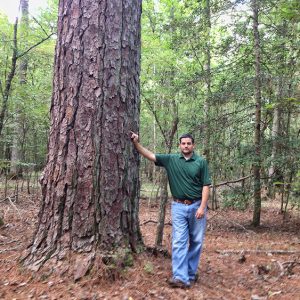calsfoundation@cals.org
Lost 40
The Lost 40 is a forty-acre tract of mature forest along Wolf Branch (a tributary of Moro Creek) in southeastern Calhoun County. Owned by PotlatchDeltic Corporation, the tract is known for its large trees, some more than 200 years old, and has variously been described as “primary,” “virgin,” and “old-growth.” It has been the site of several scientific studies conducted by the faculty and students of the University of Arkansas at Monticello (UAM) School of Forestry and Natural Resources, and is protected by a forty-year cooperative management agreement between PotlatchDeltic and the Arkansas Natural Heritage Commission (ANHC) signed in 1996. Lost Forty Brewing, a brewery based in Little Rock (Pulaski County), takes its name from the tract.
Several natural communities or forest types are present on the land, sorted among various soil types and microtopographic features (flats, mounds, low ridges, and sloughs), but it is generally described as a mixed bottomland hardwood-loblolly pine forest. The ANHC has documented nearly 150 species of plants in the tract, including thirty-eight different kinds of trees. Common species include pawpaw (Asimina triloba), musclewood (Carpinus caroliniana), mockernut hickory (Carya alba), water hickory (Carya aquatica), pignut hickory (Carya glabra), persimmon (Diospyros virginiana), American holly (Ilex opaca), sweet-gum (Liquidambar styraciflua), blackgum (Nyssa sylvatica), hop hornbeam (Ostrya virginiana), loblolly pine (Pinus taeda), white oak (Quercus alba), overcup oak (Quercus lyrata), cow oak (Quercus michauxii), water oak (Quercus nigra), cherrybark oak (Quercus pagoda), willow oak (Quercus phellos), bald-cypress (Taxodium distichum), and American basswood (Tilia americana). Trees as large as four feet in diameter and more than 150 feet tall have been documented.
Numerous stories are told about the origin of the tract’s name and the purported reason that it was never logged. One version claims that Moro Creek, which is the boundary between Bradley and Calhoun counties, changed its course, resulting in uncertainty about which county the tract was in. Taxes were paid in both counties, which led to a lengthy dispute over its ownership, preventing the timber from being cut. Another version holds that the foresters who worked for the various companies that owned it in the mid-twentieth century recognized the increasing rarity of such mature trees and, when they were sent out to mark the trees to be cut, would claim that they could not find or access the tract. Regardless, the tract has escaped logging and supports a diverse forest with large examples of many tree species.
In a 1996 site report prepared to accompany the cooperative management agreement, ANHC ecologist Tom Foti summarized the site’s unique natural area values as follows:
…its principal natural area value may be its ability to serve as a “living library” of information on forest structure, composition and dynamics in the Coastal Plain prior to massive alteration by our ancestors. Only by study of such areas can scientists learn the composition of the presettlement forest and how it changed in the absence of management by people. The ANHC knows of only a handful of such areas dominated by pines or pines and hardwoods within the entire 20% of the state occupied by the Coastal Plain. This region has been too accessible and its timber too valuable to allow areas such as the Lost 40 to escape the attention of loggers, farmers, and others. It is a tribute to the succession of foresters who have managed this property that they have resisted the economic temptations offered by such large trees. Since areas of this kind are so rare in this region and since no others offer a similar mix of large pines and hardwoods, the Lost 40 represents a unique opportunity to learn about stand dynamics of an old-growth pine-hardwood forest.
While the Lost 40 is protected through a voluntary agreement with the ANHC, it is not part of the public System of Natural Areas but is private property owned by PotlatchDeltic. It is leased to a private hunting club and is not open to the public without advance permission from the landowner.
For additional information:
Bragg, D. C. “Composition, Structure, and Dynamics of a Pine-Hardwood Old-Growth Remnant in Southern Arkansas.” Journal of the Torrey Botanical Society 131 (2004): 320–336.
Chaney, Rachel O’Neal. “Forest for the Trees.” Arkansas Democrat-Gazette, August 12, 2012, pp. 1E, 6E.
Grell, A. G., M. G. Shelton, and E. Heitzman. “Influences of Elevation of Overstory Species Composition in an Old-Growth Bottomland Hardwood-Loblolly Pine Forest in Southern Arkansas.” In Proceedings of the 12th Biennial Southern Silvicultural Research Conference, edited by K. F. Connor. Gen. Tech. Rep. SRS-71. Asheville, NC: U.S. Dept. of Agriculture, Forest Service, Southern Research Station, 2004.
Grell, A. G., M. G. Shelton, and E. Heitzman. “Changes in Plant Species Composition along an Elevation Gradient in an Old-Growth Bottomland Hardwood-Pinus taeda Forest in Southern Arkansas.” Journal of the Torrey Botanical Society 132 (2005): 72–89.
Heitzman, E., M. G. Shelton, and A. G. Grell. “Species Composition, Size Structure, and Disturbance History of an Old-Growth Bottomland Hardwood-Loblolly Pine (Pinus taeda L.) Forest in Arkansas, USA.” Natural Areas Journal 24 (2004): 177–187.
Theo Witsell
Arkansas Natural Heritage Commission
 Environment
Environment Lost 40
Lost 40  Lost 40
Lost 40 




Please never cut it. This is as rare as hens’ teeth!